- Bacterial vaginosis (BV) is an extremely common vaginal infection caused by an overgrowth of bad bacteria and is often linked to sex and sexual activity.
- Men cannot get BV, but they can instigate, prolong, and retrigger BV infections.
- Avoid sex for 7 days after completing any treatment for BV, and take steps with your partner to avoid recurrent infection for the weeks and months afterward.
- Along with sex, poor hygiene practices, douching, and use of antibiotics are some of the risk factors that can increase your chances of getting BV.
- It’s important to seek treatment from a healthcare professional for any active BV infections.
If you have a vagina, you are probably familiar with bacterial vaginosis or BV. And how could you not be? Bacterial vaginosis is one of the most common vaginal infections caused by an overgrowth of certain types of bacteria within the vaginal flora.
BV is often annoying, uncomfortable, or even embarrassing. And if you’ve noticed new infections or increased infections after becoming sexually active with a new partner, you might be wondering, “Can men get BV? Does my partner have BV and giving it to me?”
The answer is both yes and no. No, your male partner cannot have BV because they don’t have a vagina. But yes, they can be contributing to your own recent BV infections. How is that possible? Let’s dive into it.
Can you get BV from a male partner?
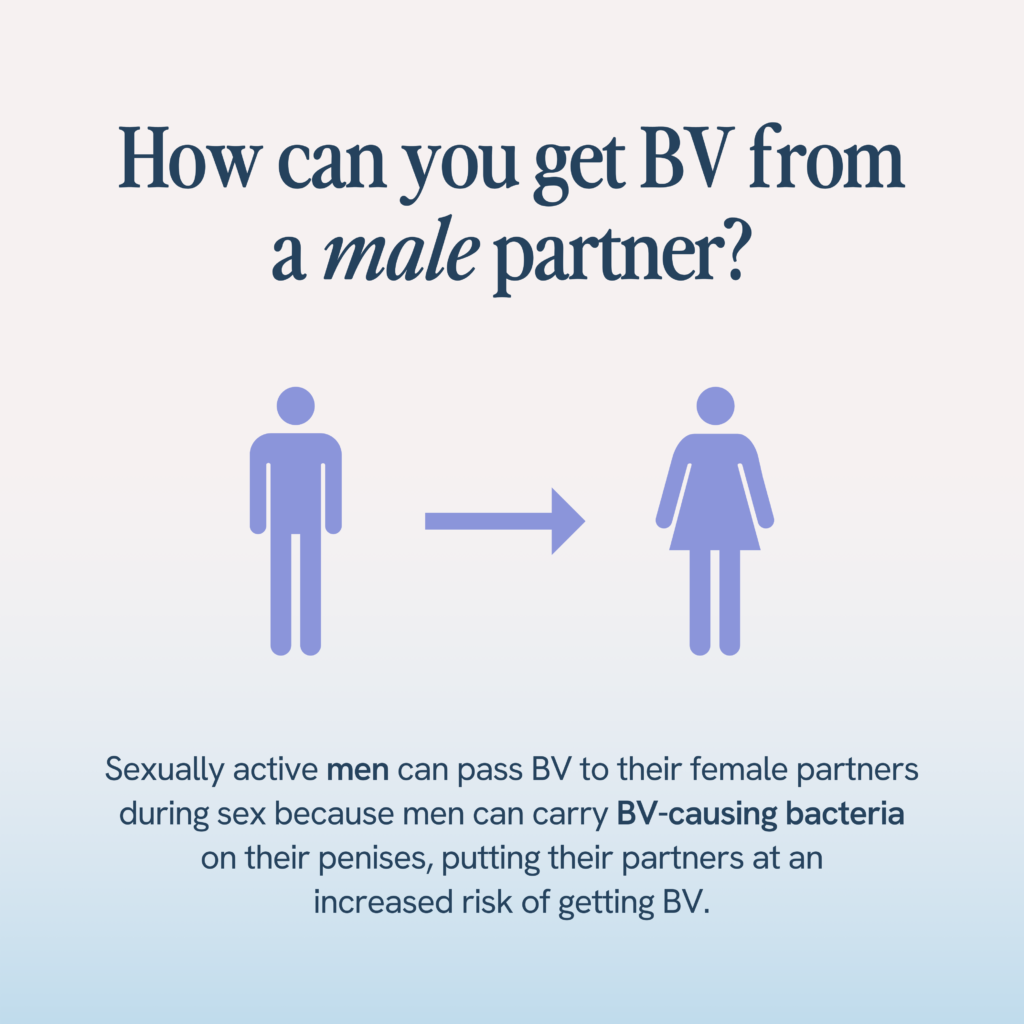
While men cannot experience BV themselves because they don’t have a vagina, research suggests that sexually active men can pass BV to their female partners during sex. One particular study of 165 uncircumcised men with multiple female partners actually found these men carried BV-causing bacteria on their penises, putting their partners at an increased risk of getting BV.
How long can a man carry BV-causing bacteria?
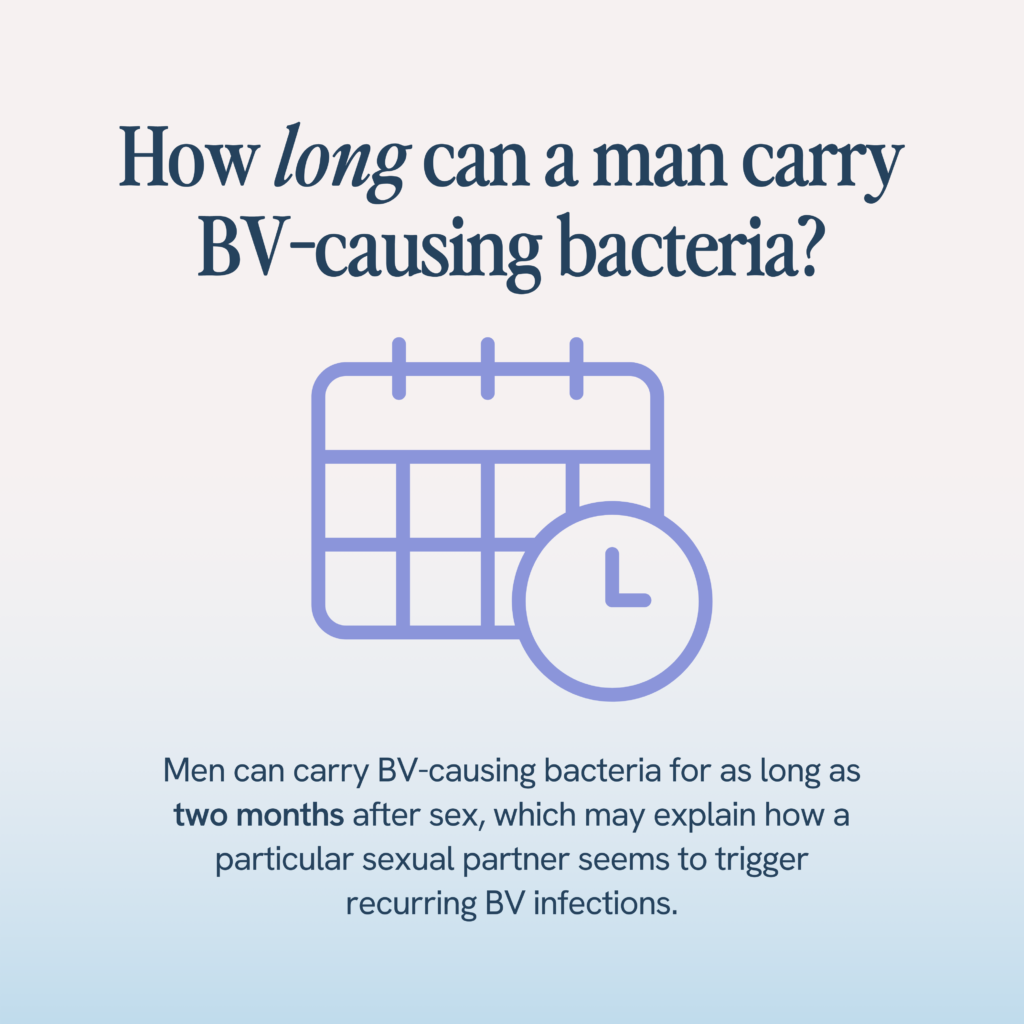
One study recently published in Cell Reports Medicine found that men having vaginal sex not only carried the bacteria associated with bacterial vaginosis but that the bacteria was detectable for at least two months after sex. Which is… not ideal for us females and can explain how a particular sexual partner seems to trigger recurring BV infections.
If you’re getting BV from sex, does that make BV a sexually transmitted infection (STI)?
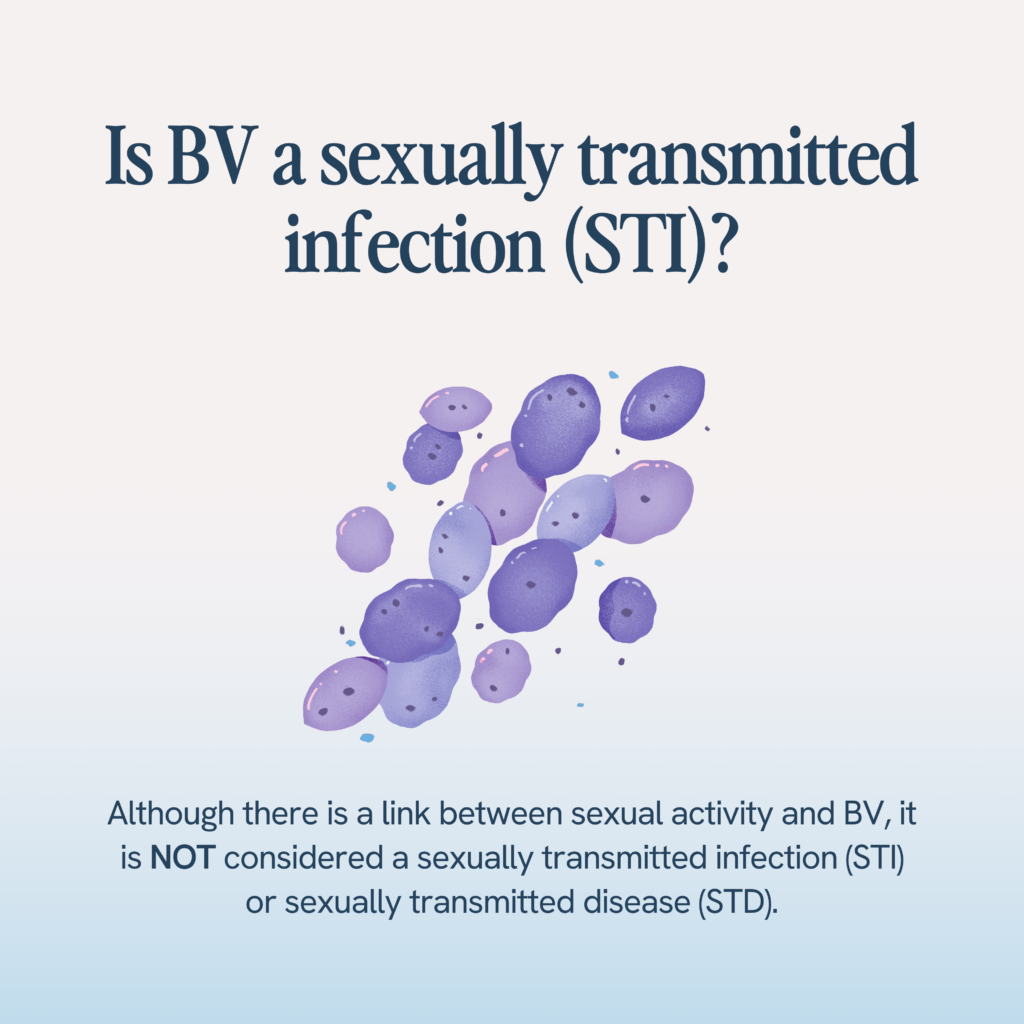
No. Although there is a link between sexual activity and BV, the Centers for Disease Control and Prevention (CDC) does not consider BV to be a sexually transmitted infection (STI) or sexually transmitted disease (STD). While BV is more prevalent in people who are having sex, particularly those having unprotected sex or sex with multiple partners, people who are not sexually active can also get BV.
Unlike BV and vaginal yeast infections, STIs can affect men and women both. Some common examples of STIs include:
- Syphilis (Treponema Pallidum)
- Genital herpes (Herpes Simplex Virus – HSV)
- Gonorrhea (Neisseria gonorrhoeae)
- Trichomoniasis (Trichomonas vaginalis)
- Chlamydia (Chlamydia trachomatis)
If BV is not an STI, why do BV symptoms worsen after sex?
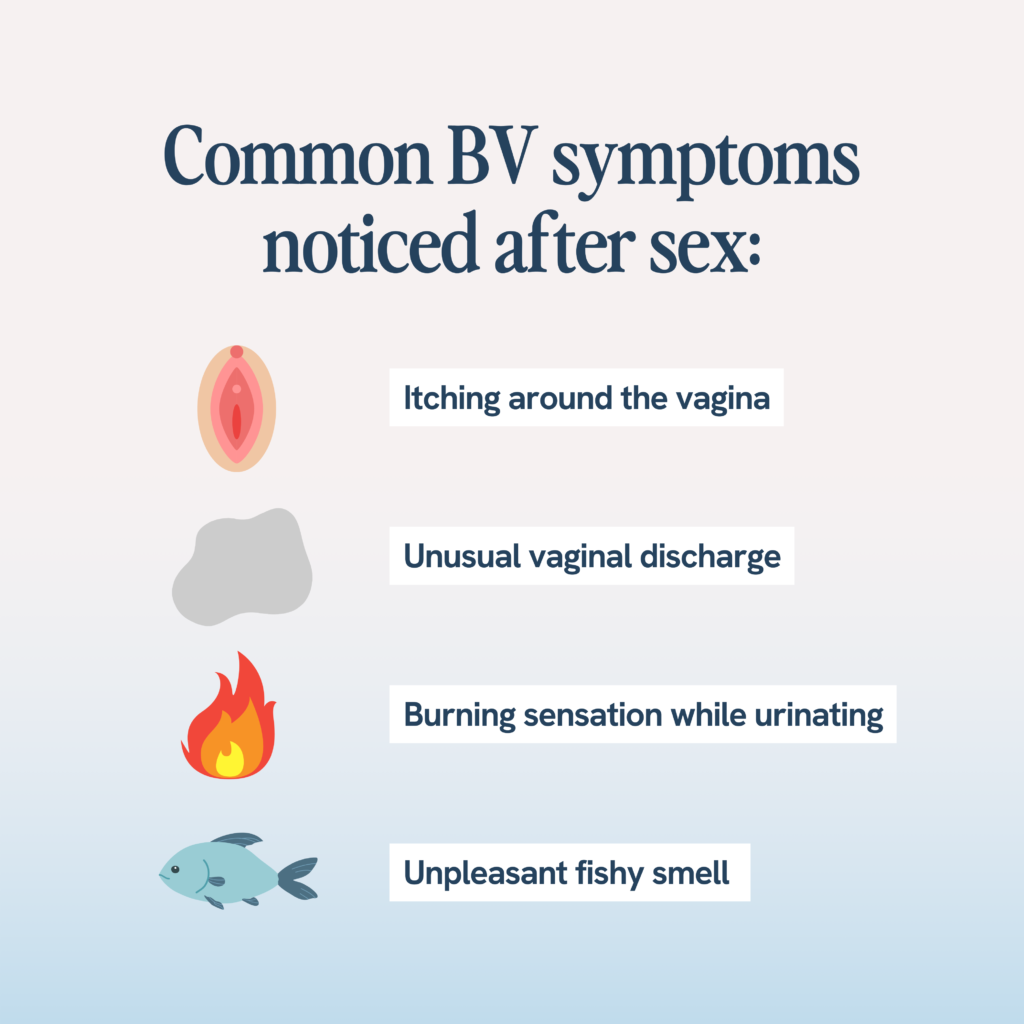
If you have noticed your BV symptoms seem to increase or worsen after sex, you aren’t alone. The most common BV symptoms noticed after sex are:
- Unusual vaginal discharge
- Unpleasant fishy smell
- Itching around the outside of the vagina
- Burning sensation while urinating

This is because not only does vaginal sex introduce or reintroduce bad, BV-causing bacteria to your vaginal microbiome (and remember, BV-causing bacteria can live on a penis for more than 2 months), but vaginal sex can also irritate the vagina, worsening the discomfort that comes from BV.
If you have BV, can you give it to your male partner?
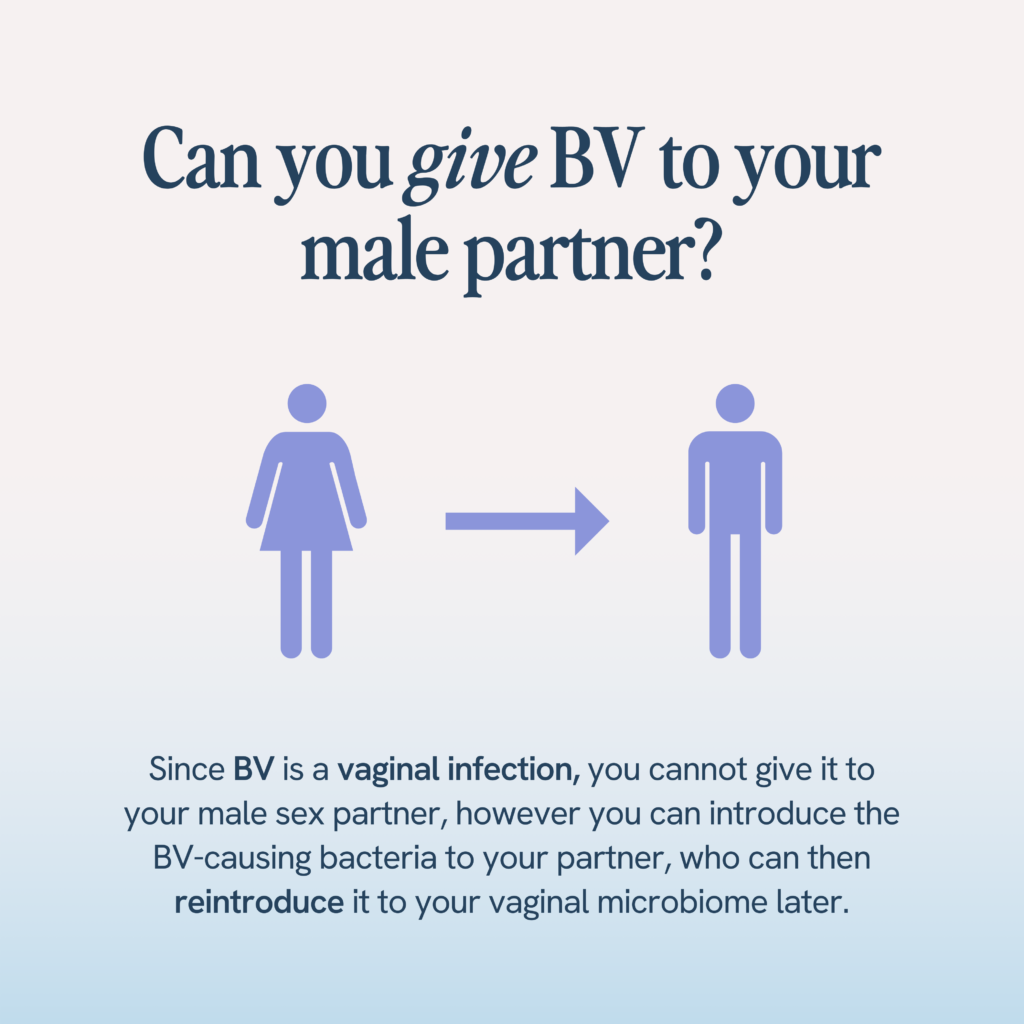
No, you cannot give BV to your male sex partner. Remember, BV is a vaginal infection, so a vagina is definitely required. But you can introduce the BV-causing bacteria to your partner, who can then reintroduce it to your vaginal microbiome later, instigating a second infection.
So… can you have sex with BV or not?
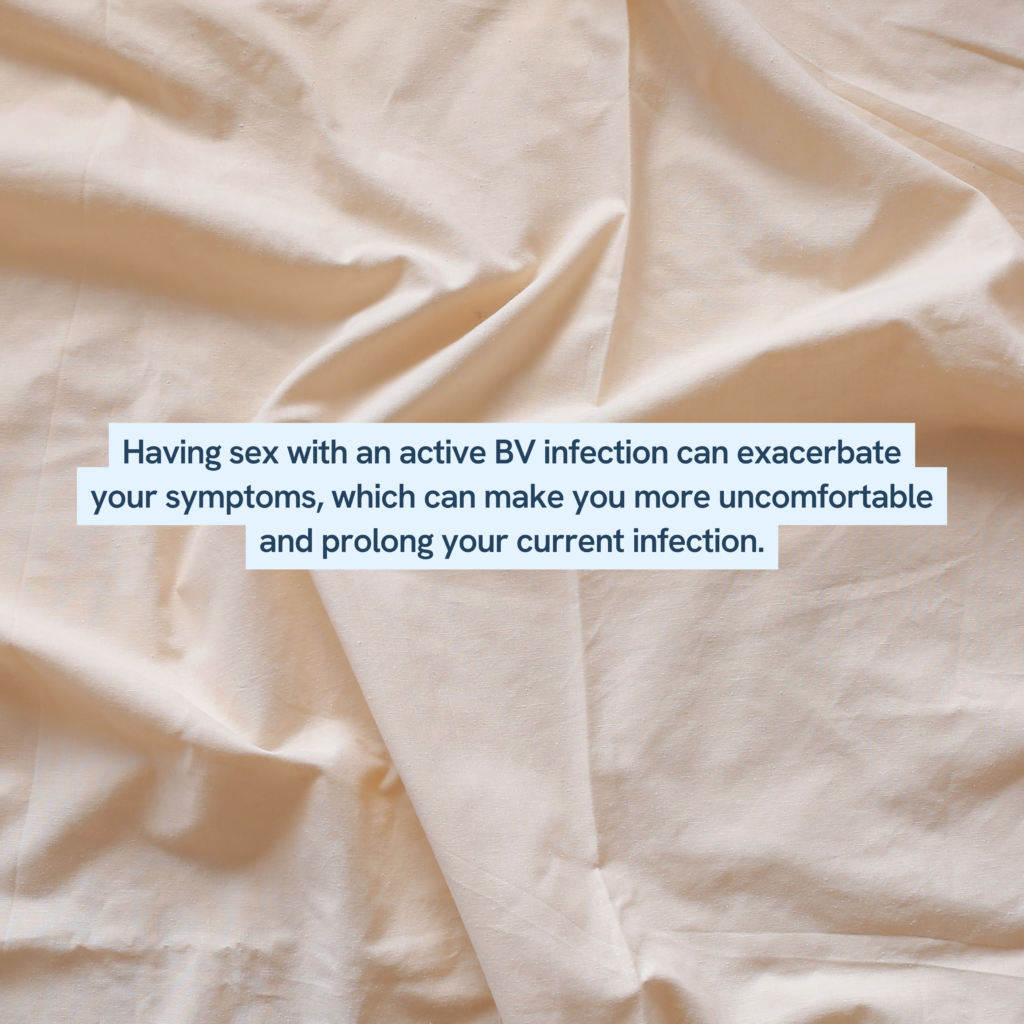
Can you? Sure. Should you? Probably not. As we said, it can exacerbate BV symptoms, which can not only make you more uncomfortable than necessary but can prolong your current infection and put you at increased risk of recurrent BV from your partner.
But what if you’re getting treatment? Can you have sex while treating BV?
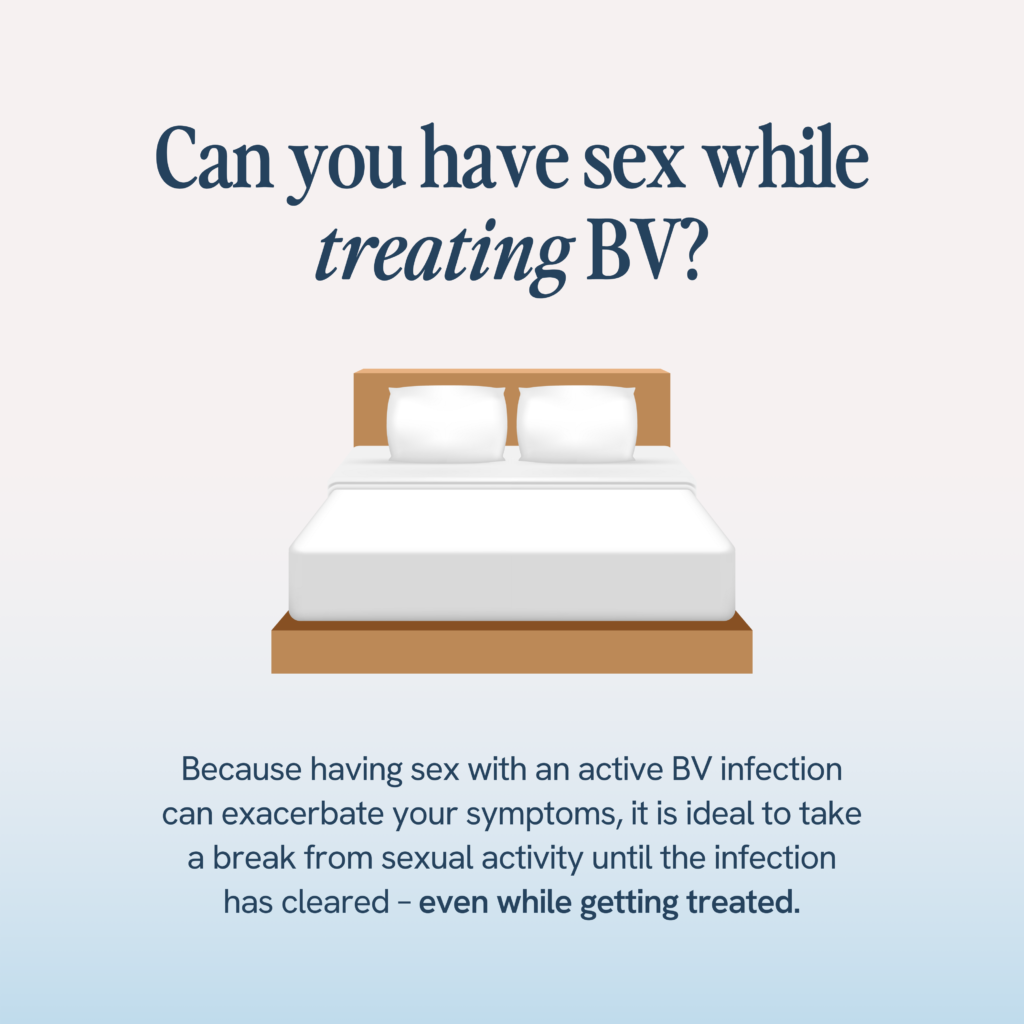
Same answer as above. Yes, you can have sex while receiving an antibiotic treatment like metronidazole, but you probably shouldn’t. Recurrent BV is no joke, so do what you need to to clear the infection entirely.
Okay, so long do you have to wait for sex after BV treatment?

This is a great question to ask your healthcare provider or gynecologist when they first prescribe you a BV treatment like antibiotics. But generally, the rule of thumb regarding BV and sex is to wait at least 7 days AFTER completing your full round of antibiotics. So if you get prescribed a 3-day round of antibiotics or a 7-day round, add another 7 days to that before resuming sexual activity.
How do you avoid getting recurrent BV from your partner?
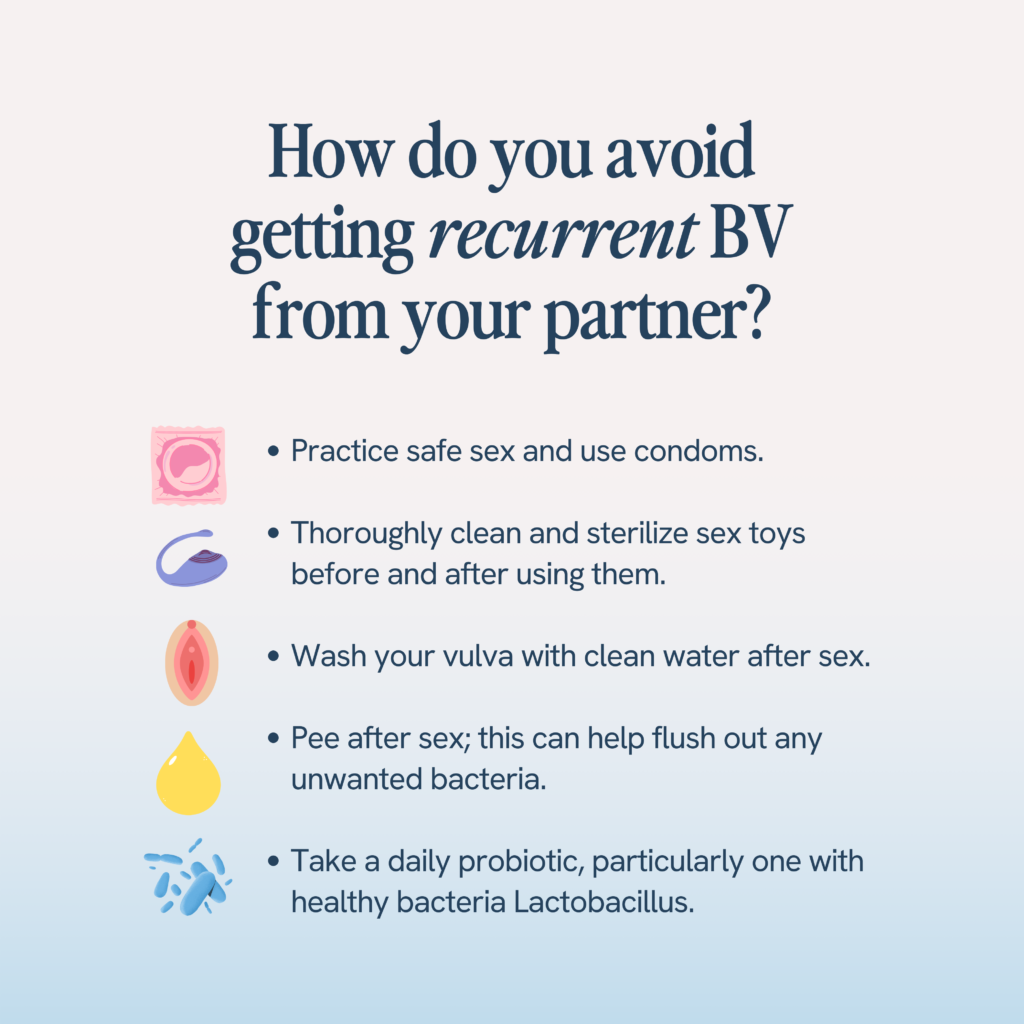
The math doesn’t exactly add up, right? Because even if you wait 7 days after completing your antibiotic prescription, the BV-causing bacteria living on your partner’s penis can stay alive for another month or more. That’s why it’s so easy to fall into the cycle of recurrent BV. But it’s also an easy cycle to break if you know how to practice good sex hygiene.
To prevent recurrent BV:
- Practice safe sex and use condoms
- Clean and sterilize sex toys before engaging in any sexual activity (yes, every single time!)
- Wash your vaginal thoroughly with clean water after having sex
- Go to the bathroom after having sex since urination can help flush out any unwanted bacteria from your vagina
- Take a daily probiotic, particularly one that has the healthy bacteria Lactobacillus. Lactobacillus is responsible for maintaining your overall vaginal pH, which can help kill any bad bacteria that gets reintroduced
Besides sex, what are other common risk factors of BV?
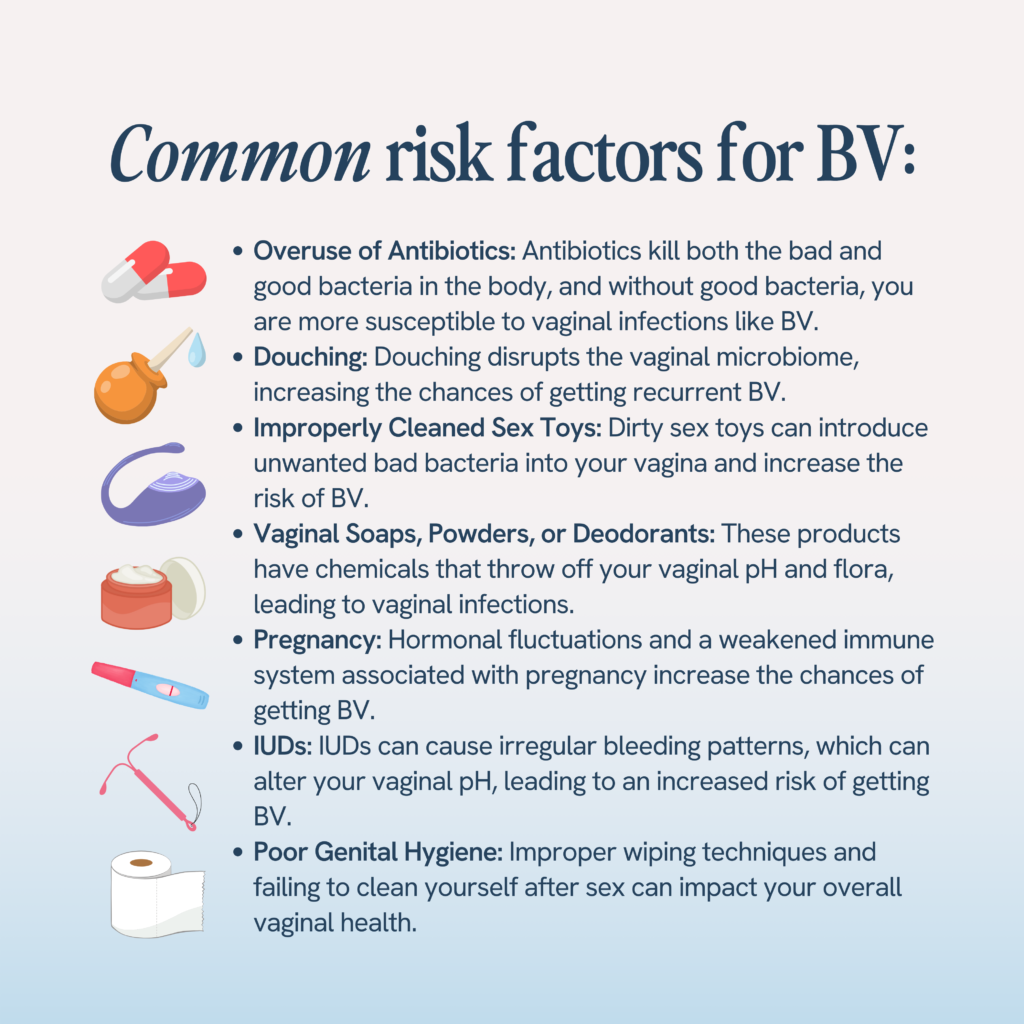
At its core, BV is due to an imbalance in vaginal pH. Something disrupts your vaginal microbiome, affecting your healthy bacteria levels and making it easier for bad bacteria to grow.
Sex, unprotected sex, and multiple or new sexual partners can all disrupt your vaginal pH, leading to BV, but there are other risk factors, too, including:
1. Overuse of antibiotics
When you take antibiotics, you are killing not only the bad, infection-causing bacteria but all the good ones, too. Without good bacteria, you are more susceptible to vaginal infections like BV and vaginal yeast infections.
2. Douching
Douching is the process of flushing your vagina using water or other OTC cleansers. Though it’s seen as a way to clean your vagina, most doctors actually recommend against it. First, the vagina is self-cleaning (which is amazing, right?) But more than that, when you douche, you are disrupting your vaginal microbiome, which is probably why people who douche are more likely to get recurrent BV than those who don’t.
3. Improperly cleaned sex toys
Dirty sex toys can introduce unwanted bad bacteria into your vagina and increase the risk of BV. So wash any toys thoroughly before and after use.
4. Vaginal soaps, powders, or deodorants
As good as these products might smell, the chemicals in them can throw off your vaginal pH and the overall balance of bacteria within your vagina, leading to BV and yeast infections. Swap fancy vaginal cleansers for warm water and mild, unscented soap.
5. Pregnancy
We know, as if pregnancy wasn’t uncomfortable enough, right? Due to hormonal fluctuations and the weakened immune system associated with pregnancy, pregnant women are more likely to get BV.
6. IUDs
If you use an intrauterine device or IUD for contraception, you can experience irregular bleeding patterns, which can alter your vaginal pH. This is why IUDs are associated with an increased risk of getting BV.
7. Poor genital hygiene
Little things like improper wiping techniques and failing to clean yourself after sex can have a big impact on your overall vaginal health, particularly when it comes to vaginal infections.
What happens if you leave BV untreated?
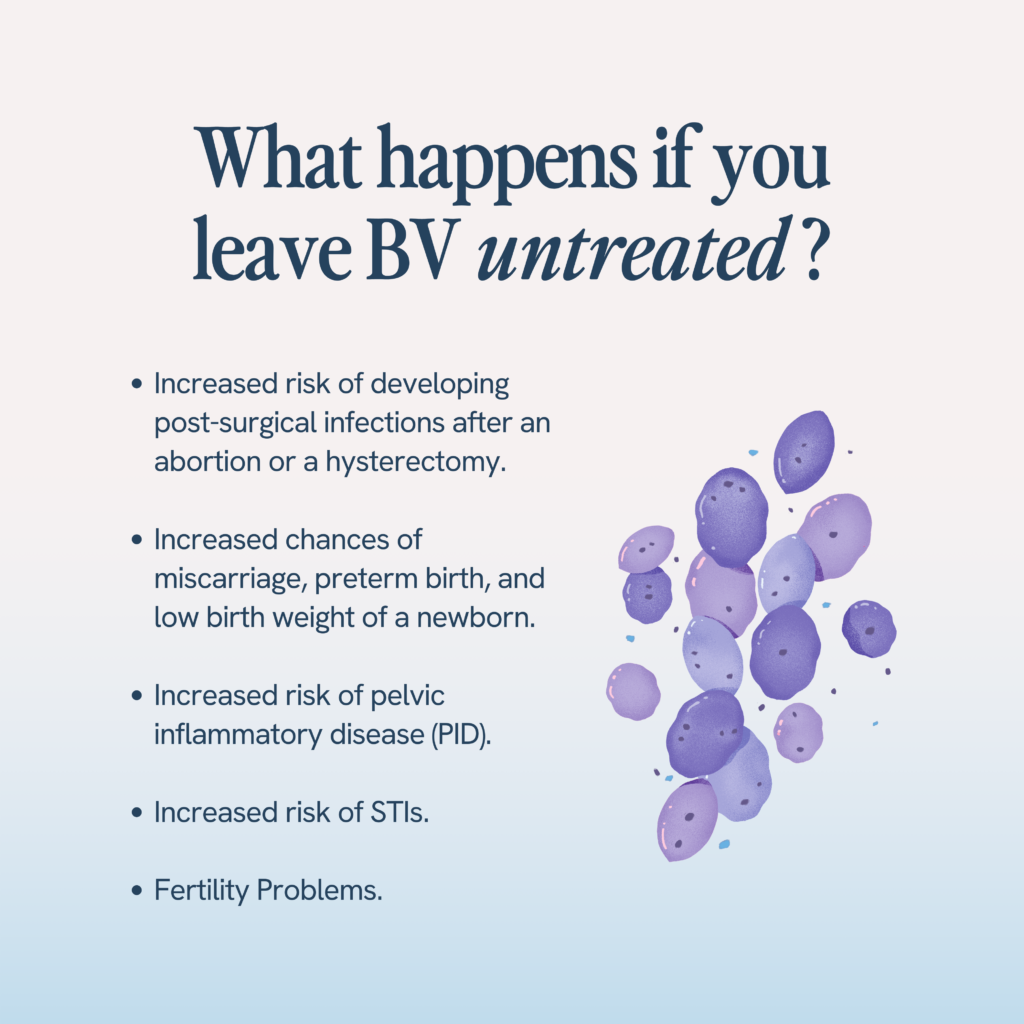
We know that chronic and recurrent BV can be frustrating, especially if you feel like it is linked to a particular sexual partner. And if giving up that partner isn’t an option, you should just give up hope of ever treating the BV, right? Wrong.
You can break the cycle of recurrent BV, and more than that, it’s important you do. Leaving BV untreated has been linked to:
- Increased risk of STIs
- BV and STIs also increase your risk of getting HIV AIDS
- Increased risk of developing post-surgical infections after an abortion or a hysterectomy
- Fertility problems
- Increased chances of miscarriage, preterm birth, and low birth weight of a newborn
- Increased risk of pelvic inflammatory disease (PID) – inflammation and infection of the ovaries, uterus, or fallopian tubes that can result in infertility
Your healthcare provider or gynecologist can be a great ally if you don’t know where to start. They will likely prescribe you a course of antibiotics like metronidazole, clindamycin, or tinidazole), and if you follow the instructions exactly as prescribed and also incorporate a daily probiotic into your routine, we have confidence you will be feeling a lot better and fast!
References
Bacterial Vaginosis (BV) Statistics, Centers for Disease Control and Prevention (CDC), https://www.cdc.gov/std/bv/stats.htm. Accessed on July 3, 2023.
Hesham, H., Mitchell, A. J., Bergerat, A., Hung, K., & Mitchell, C. M. (2021). Impact of vaginal douching products on vaginal Lactobacillus, Escherichia coli and epithelial immune responses. Scientific reports, 11(1), 23069. https://doi.org/10.1038/s41598-021-02426-5
Madden, T., Grentzer, J. M., Secura, G. M., Allsworth, J. E., & Peipert, J. F. (2012). Risk of bacterial vaginosis in users of the intrauterine device: a longitudinal study. Sexually transmitted diseases, 39(3), 217–222. https://doi.org/10.1097/OLQ.0b013e31823e68fe
Liu, C. M., Hungate, B. A., Tobian, A. A., Ravel, J., Prodger, J. L., Serwadda, D., Kigozi, G., Galiwango, R. M., Nalugoda, F., Keim, P., Wawer, M. J., Price, L. B., & Gray, R. H. (2015). Penile Microbiota and Female Partner Bacterial Vaginosis in Rakai, Uganda. mBio, 6(3), e00589. https://doi.org/10.1128/mBio.00589-15





